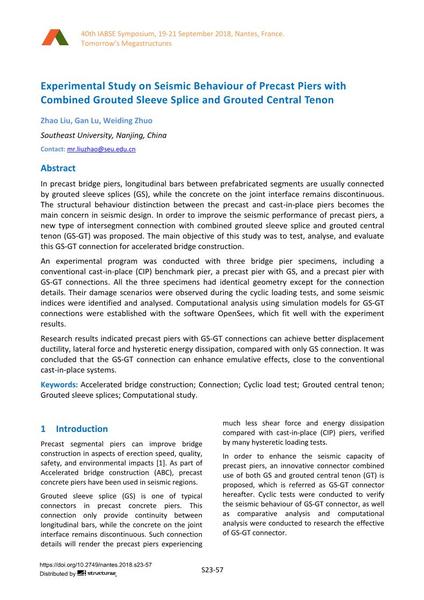Experimental Study on Seismic Behaviour of Precast Piers with Combined Grouted Sleeve Splice and Grouted Central Tenon

|
|
|||||||||||
Bibliographic Details
| Author(s): |
Zhao Liu
Gan Lu (Abstract) Weiding Zhuo |
||||
|---|---|---|---|---|---|
| Medium: | conference paper | ||||
| Language(s): | English | ||||
| Conference: | IABSE Symposium: Tomorrow’s Megastructures, Nantes, France, 19-21 September 2018 | ||||
| Published in: | IABSE Symposium Nantes 2018 | ||||
|
|||||
| Page(s): | S23-57 | ||||
| Total no. of pages: | 8 | ||||
| DOI: | 10.2749/nantes.2018.s23-57 | ||||
| Abstract: |
In precast bridge piers, longitudinal bars between prefabricated segments are usually connected by grouted sleeve splices (GS), while the concrete on the joint interface remains discontinuous. The structural behaviour distinction between the precast and cast-in-place piers becomes the main concern in seismic design. In order to improve the seismic performance of precast piers, a new type of intersegment connection with combined grouted sleeve splice and grouted central tenon (GS-GT) was proposed. The main objective of this study was to test, analyse, and evaluate this GS-GT connection for accelerated bridge construction. An experimental program was conducted with three bridge pier specimens, including a conventional cast-in-place (CIP) benchmark pier, a precast pier with GS, and a precast pier with GS-GT connections. All the three specimens had identical geometry except for the connection details. Their damage scenarios were observed during the cyclic loading tests, and some seismic indices were identified and analysed. Computational analysis using simulation models for GS-GT connections were established with the software OpenSees, which fit well with the experiment results. Research results indicated precast piers with GS-GT connections can achieve better displacement ductility, lateral force and hysteretic energy dissipation, compared with only GS connection. It was concluded that the GS-GT connection can enhance emulative effects, close to the conventional cast-in-place systems. |
||||
| Keywords: |
connection accelerated bridge construction Cyclic load test Grouted central tenon Grouted sleeve splices computational study
|
||||
